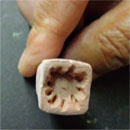IMPRESSING - Clay.
Click on the title to see more images Impressing is to indent a design or textures into soft clay by pressing different shaped objects into it. Materials with strong textures, such as canvas, or objects like rings, coins, crosses, etc. can be used.
Impressing is to indent a design or textures into soft clay by pressing different shaped objects into it. Materials with strong textures, such as canvas, or objects like rings, coins, crosses, etc. can be used.
IMPRESSING TOOLS: Roulette wheel and stamps are the most popular and both can be bought or you can make them. They can be in wood, clay left to dry and clay fired and be with or without a handle. The design can protrude outwards or inwards and when pressed into the clay, the indent will be the reverse. Read more about: Impressing stamp
 STAMPS: If you are going to use a design continuously, make it in wood or bisque. Whatever size or shape you make your stamp, the handle must be big enough to hold comfortably while pressing face downwards into the clay. If large, make it with a handle attached to the back, like a T upside down.Read more about: Stamp – To work with clay
STAMPS: If you are going to use a design continuously, make it in wood or bisque. Whatever size or shape you make your stamp, the handle must be big enough to hold comfortably while pressing face downwards into the clay. If large, make it with a handle attached to the back, like a T upside down.Read more about: Stamp – To work with clay
 ROULETTE WHEEL: the design goes round the outside of a tube that can be clay or wood and can be rolled by hand or can have a handle attached to it. To do this, a hole must be made through the center of the tube, a piece of metal passed through it and attached to a handle.Read more about: Roulette Wheel
ROULETTE WHEEL: the design goes round the outside of a tube that can be clay or wood and can be rolled by hand or can have a handle attached to it. To do this, a hole must be made through the center of the tube, a piece of metal passed through it and attached to a handle.Read more about: Roulette Wheel
Working sequence:
a) Work out the texture or design you want to reproduce, taking into account that it is going to be used several times on the same piece of clay to form a repeated pattern.
b) Roll out a solid tube of clay of the required size in width and length for your design.
c) For a stamp, carve out a design at one or both ends of the tube.
d) If it is a tube that is going to be rolled, carve out the pattern and calculate that the pattern fits exactly into the circumference, so it repeats correctly. If a handle is needed, cut a hole through the center.
e) Leave the clay to dry. It can be used when it is dry but for large quantizes and continuous use, fire it.
f) Roll or stamp the pattern over soft clay to indent it.
Photos lent by: a) by Josep Matés / b) – h) Núria Pié.
Link to the viedo where photos b) to d) have been taken – Núria Pié
 Impressing stamps; you can use anything to mark or make a texture in clay. It could be a leaf, the flat end of a pencil or a sole of a shoe. The clay should be flat and you must work on a surface where it can be left, like a modeling board or a mold.
Impressing stamps; you can use anything to mark or make a texture in clay. It could be a leaf, the flat end of a pencil or a sole of a shoe. The clay should be flat and you must work on a surface where it can be left, like a modeling board or a mold. Incising is to engrave a design by cutting or scraping into the clay surface at any stage of drying, from soft to bone dry. With hard bone-dry clay you will obtain more precise lines, but you have to be very careful that it does not break. After incising, clean off the loose bits with a strong brush, then smooth the edges with a soft damp brush. Incising is useful for making textures.
Incising is to engrave a design by cutting or scraping into the clay surface at any stage of drying, from soft to bone dry. With hard bone-dry clay you will obtain more precise lines, but you have to be very careful that it does not break. After incising, clean off the loose bits with a strong brush, then smooth the edges with a soft damp brush. Incising is useful for making textures. 

